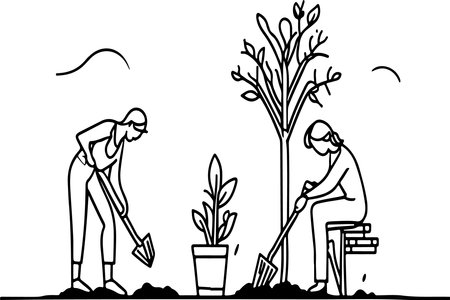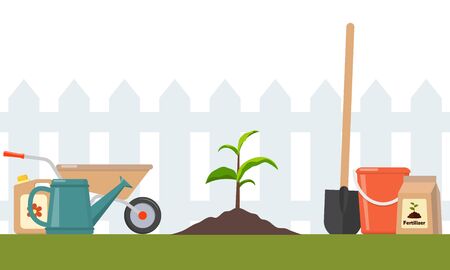Understanding Allotments in the UK
Allotments are a cherished part of British culture, offering individuals and communities the opportunity to cultivate their own fruits, vegetables, and flowers on designated plots of land. The concept dates back to the nineteenth century, emerging as a response to urbanisation and industrialisation, when green spaces became scarce for many working families. Over time, allotments have evolved into vital community assets that promote sustainability, wellbeing, and social interaction.
The Historical Context
The roots of allotments can be traced to the Enclosure Acts and subsequent movements advocating for public access to land. During both World Wars, allotment gardening played a crucial role in supplementing food supplies through initiatives like “Dig for Victory.” Today, this historical legacy endures, making allotments not only practical but also symbolic of resilience and self-sufficiency.
Purpose and Benefits
Modern allotments serve multiple purposes. They provide space for growing organic produce, encourage physical activity, and support mental health by connecting people with nature. Allotments also foster a sense of belonging within local communities, as plot holders often share tips, surplus crops, and participate in communal events.
Community Significance
Allotment sites frequently act as social hubs where neighbours collaborate on projects or simply enjoy each others company. Many sites host open days and competitions, further strengthening community ties. These spaces contribute to local biodiversity and environmental stewardship by encouraging sustainable gardening practices.
Local Management
Allotments are typically managed by local authorities or allotment associations. Councils oversee waiting lists, allocate plots, and set guidelines for cultivation and maintenance. Associations often take on day-to-day management tasks such as organising meetings, maintaining communal areas, and representing plot holders interests. This structure ensures that allotments remain accessible, well-maintained, and responsive to the needs of local residents.
Securing Your First Allotment Plot
Embarking on your allotment journey in the UK begins with securing a plot, a process that involves working with your local council or an allotment association. Understanding the steps and knowing what to expect will help you navigate this phase efficiently.
How to Apply for an Allotment
Most allotments are managed by either local authorities or independent associations. The application process is straightforward but may differ slightly depending on your location. Generally, you will:
- Identify local allotment sites through your council’s website or by searching the National Allotment Society’s directory.
- Complete an application form online or in person, providing your name, address, and contact details.
- Submit your application and wait for confirmation of receipt from the relevant body.
Application Channels Comparison
| Channel | Managed By | Typical Process | Pros | Cons |
|---|---|---|---|---|
| Local Council | Council Office | Apply via council website or office; join waiting list | Standardised process; usually more plots available | Bureaucratic; longer waits in urban areas |
| Allotment Association | Voluntary Group | Contact association directly; may require membership fee | Tighter community; possible shorter waiting times | Limited availability; specific rules and fees |
Selecting the Right Site
Your choice of site can impact both convenience and success. Consider these factors when choosing:
- Proximity: Choose a site within easy reach of your home to encourage regular visits.
- Amenities: Look for sites with water supply, tool storage, secure fencing, and parking.
- Community: Some sites offer vibrant social scenes or active gardening groups, which can provide valuable support for beginners.
- Soil Quality and Sunlight: If possible, inspect prospective plots for healthy soil and good sunlight exposure.
What to Expect from Waiting Lists
The demand for allotments has surged in recent years, particularly in densely populated areas. Waiting times can range from several months to several years. Here is what you should know:
- Acknowledgement: After applying, you will typically receive a confirmation email or letter acknowledging your place on the waiting list.
- Status Updates: Councils may send annual updates; some associations are more informal—don’t hesitate to contact them periodically for news.
- Multiple Applications: You can apply to several sites at once to improve your chances but must accept only one plot if offered.
- Cancellations: Sometimes plots become available unexpectedly—be prepared to respond quickly if contacted.
Top Tip: Be Patient and Proactive!
The wait can be long, but persistence pays off. In the meantime, consider joining gardening clubs or volunteering at community gardens to build knowledge and connections while you await your first plot.

3. Planning Your Allotment Layout
Designing a Productive and Manageable Plot
Thoughtful planning is the cornerstone of a successful allotment in the UK. Start by assessing the size and shape of your plot, as well as its orientation towards the sun. Many British allotment holders opt for traditional rectangular beds separated by narrow paths, making crop rotation and maintenance much easier. Consider raised beds if your soil is heavy or drainage is an issue—these are particularly beneficial during the wet British winters.
Soil Preparation: The Foundation of Growth
Before planting, invest time in preparing your soil. Most UK soils benefit from annual digging or no-dig methods, depending on personal preference. Test your soil’s pH and structure; most vegetables thrive in slightly acidic to neutral soils (pH 6–7). Incorporate well-rotted manure or garden compost to enrich the ground, improve texture, and boost fertility. Remove perennial weeds thoroughly, as they can be persistent nuisances throughout the growing season.
Selecting Crops for the UK Climate
The variable British weather calls for choosing crops suited to local conditions. Popular and reliable choices include potatoes, carrots, onions, leeks, cabbages, peas, beans, and soft fruits like strawberries and raspberries. If you’re new to growing, start with hardy varieties that cope well with cooler temperatures and unpredictable rainfall. Stagger sowing times for salad crops such as lettuce and radishes to ensure a continuous harvest throughout the summer months.
Sustainable Growing Practices
Adopting sustainable techniques not only benefits your plot but also supports the wider environment. Practice crop rotation to prevent disease build-up and maintain soil health—typically on a three- or four-year cycle. Companion planting can help deter pests naturally; for example, planting marigolds among vegetables attracts beneficial insects. Collect rainwater in water butts for irrigation and use mulch to retain soil moisture and suppress weeds. By integrating these practices into your allotment layout, youll create a resilient and productive space that thrives year after year.
4. Essential Tools and Equipment
Starting your first allotment in the UK requires a selection of reliable tools and equipment, tailored to both novice and seasoned gardeners. Investing wisely in quality basics will make your gardening experience more efficient, enjoyable, and resilient against the unpredictable British weather. Below, we outline the essential items, suggest where to source them, and provide tips for budget-friendly choices.
Must-Have Tools for Allotment Beginners
| Tool | Purpose | Recommended Features |
|---|---|---|
| Spade | Digging, turning soil, planting | Sturdy handle, rust-resistant blade |
| Fork | Breaking up soil, removing weeds | Strong tines, comfortable grip |
| Hoe | Cultivating soil, weed control | Lightweight, sharp blade |
| Watering Can/Hose | Irrigation during dry spells | Removable rose head, long reach |
| Hand Trowel & Fork | Planting seedlings, small-scale digging | Ergonomic design, durable metal |
| Secateurs/Pruners | Trimming plants, harvesting crops | Sharp blades, easy locking mechanism |
| Rake | Smoothing soil, clearing debris | Rustproof head, strong shaft |
| Gardening Gloves | Hand protection from thorns & cold weather | Waterproof, reinforced fingertips |
| Kneeling Mat or Pad | Knee protection on damp ground | Cushioned, waterproof material |
| Shed or Storage Box (Optional) | Secure tool storage on site | Weatherproof with lockable door/lid |
Sourcing Tools: Where to Buy and What to Consider
- Garden Centres & DIY Stores: B&Q, Homebase, and local garden centres offer a broad selection of tools suitable for beginners and experienced gardeners alike.
- Allotment Associations: Many sites have shop sheds selling discounted tools and compost; ask your site representative about membership perks.
- Online Marketplaces: Websites such as eBay, Gumtree, and Freecycle are excellent for finding pre-loved tools at bargain prices—ideal for budget-conscious gardeners.
- Pound Shops & Supermarkets: For basic hand tools and gloves, budget retailers often stock seasonal garden ranges at lower prices.
Budget-Friendly Tips for UK Gardeners
- Select Quality Over Quantity: Invest in core items that withstand wet British conditions. Stainless steel or galvanised finishes help prevent rust.
- Avoid False Economy: Cheap tools may need frequent replacement. Spend a little more on essentials like spades and secateurs for greater longevity.
- Bargain Hunts: Check local car boot sales or community social media groups for affordable second-hand options.
- Treat and Maintain: Clean tools after use to prevent corrosion—dry thoroughly before storing. Oil wooden handles periodically to avoid splitting.
Tackling the British Weather: Tool Care Essentials
- Damp-Proof Storage: Store tools in a shed or sealed box to protect from rain and frost.
- Covers & Tarpaulins: If no shed is available, invest in heavy-duty covers to keep equipment dry onsite.
A practical set of well-chosen tools will serve you through every season on your allotment. By sourcing wisely and caring for your equipment, you’ll be well-prepared to face the challenges—and rewards—of gardening in the great British outdoors.
5. Managing Your Plot Through the Seasons
Understanding Seasonal Cycles on UK Allotments
The UK’s temperate climate dictates a structured approach to allotment management, with each season presenting distinct opportunities and challenges. Planning your tasks and planting according to the seasons ensures healthy crops and maximises your harvest.
Spring: Preparation and Early Planting
Tasks: Clear any remaining winter debris, dig over soil, apply well-rotted manure or compost, and repair paths or structures as needed.
Planting: Sow hardy vegetables such as broad beans, early potatoes, onions, shallots, carrots, parsnips, and peas. Consider starting tender crops like tomatoes and courgettes indoors.
Rotation Tip: Rotate legumes into beds previously used for brassicas to replenish nitrogen levels in the soil.
Summer: Growth Management and Succession Sowing
Tasks: Regularly weed, water during dry spells (preferably in the early morning or evening), stake tall plants, and monitor for pests such as aphids and slugs.
Planting: Continue sowing quick-maturing crops like lettuce, radishes, beetroot, and French beans for continuous harvests.
Rotation Tip: Move root vegetables into beds previously occupied by legumes to break pest cycles.
Autumn: Harvesting and Soil Care
Tasks: Harvest main crops including potatoes, squash, leeks, and brassicas. Remove spent plants and compost healthy material. Begin mulching exposed beds with organic matter.
Planting: Autumn is ideal for planting overwintering onions, garlic, and broad beans.
Rotation Tip: Brassicas thrive in beds enriched by previous legume crops—plant them now for robust growth next year.
Winter: Maintenance and Planning Ahead
Tasks: Perform essential maintenance such as tool cleaning and shed repairs. Plan next year’s crop rotation using a simple chart or diary.
Planting: Protect overwintering crops with fleece or cloches; sow green manure to improve soil structure if space allows.
Rotation Tip: Review last year’s layout to ensure no crop family occupies the same bed two years running.
Crop Rotation Techniques for UK Plots
Crop rotation is vital for preventing soil depletion and reducing disease risk. In the UK, a common three- or four-year system works well:
- Year 1: Legumes (peas/beans)
- Year 2: Brassicas (cabbages/broccoli)
- Year 3: Root crops (carrots/parsnips)
- (Optional) Year 4: Potatoes or other miscellaneous crops
This method maintains soil fertility and supports sustainable yields tailored to British growing conditions.
Sustainable Success Throughout the Year
A well-managed plot responds to seasonal change. By aligning your efforts with the UK’s climate cycles and employing effective crop rotation strategies, you’ll cultivate both a productive allotment and a deeper connection with your local environment.
6. Etiquette and Community Involvement
When embarking on your first allotment journey in the UK, understanding the unwritten rules and embracing the sense of community is just as important as cultivating crops. Allotment sites are more than plots of land—they are vibrant communities where cooperation, respect, and neighbourly spirit are highly valued.
Understanding Allotment Etiquette
Every site has its own written regulations, but many practices fall under the umbrella of traditional allotment etiquette. These include keeping your plot tidy, managing weeds to prevent them spreading to neighbouring plots, and ensuring that pathways are clear and accessible. It’s also customary to avoid using noisy machinery early in the morning or late in the evening out of consideration for others.
Respecting Your Neighbours
Building good relationships with fellow plot holders can greatly enhance your allotment experience. Greet others with a friendly hello, share surplus produce, and offer a helping hand when needed. Always seek permission before borrowing tools or entering another person’s plot, and keep pets under control at all times.
Caring for the Site
Allotments are shared spaces that rely on collective responsibility. Dispose of rubbish appropriately, use compost heaps correctly, and report any issues—such as broken gates or water leaks—to site managers promptly. Respect communal facilities like sheds, water tanks, and compost bins by leaving them clean and tidy after use.
Engaging with the Community
Most allotment sites host regular events such as plant swaps, open days, or harvest festivals. Participating in these activities is an excellent way to learn from experienced gardeners, share knowledge, and foster a sense of belonging. Many sites also have noticeboards or newsletters with information about meetings and opportunities for involvement.
Knowledge-Sharing Opportunities
The allotment community is an invaluable resource for new gardeners. Don’t hesitate to ask questions—most plot holders will be happy to offer advice on everything from soil preparation to pest control. Likewise, sharing your own experiences contributes to the collective wisdom of the site.
Embracing proper etiquette and engaging with your local allotment community not only ensures a harmonious environment but also enriches your gardening journey through collaboration and shared passion.


